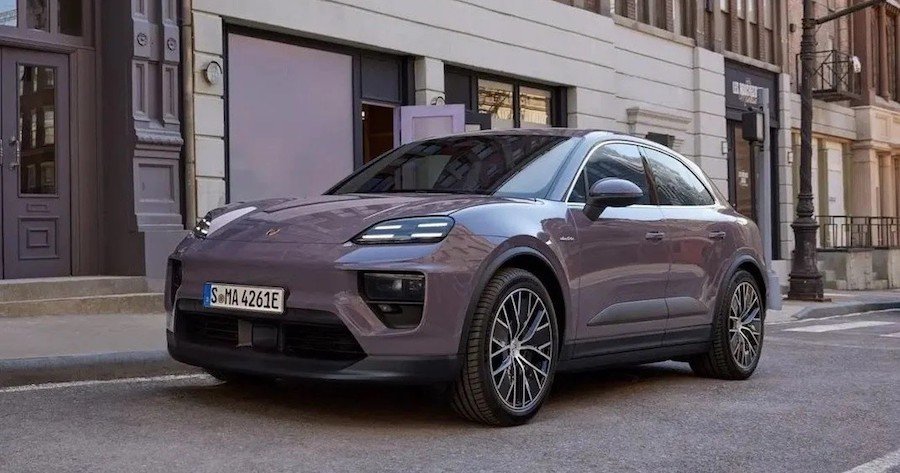The 2024 Porsche Macan Turbo Has 630 All-Electric Horsepower

Porsche’s top-selling model, the Macan, is going electric. The German brand just unveiled its new EV crossover in two guises, the 402-horsepower Macan 4 and the 630-hp Macan Turbo. This is a big deal.
Underpinning the second-generation Macan is a platform co-developed with Audi. Called Premium Platform Electric (PPE), this platform uses an 800-volt electrical architecture and will make the basis for the upcoming Audi A6 and Q6 EVs, and likely, an all-electric Porsche Cayenne.
The battery uses Lithium-Nickel Manganese Cobalt cells arranged in 12 modules for a net capacity of 95 kWh (100 kWh gross). Porsche was the first automaker to make an 800-volt production EV with the Taycan, and this higher-voltage architecture allows for a reduction in copper usage and faster charging speeds. Find an 800-volt DC charger and the Macan can charge at up to 270 kW. If you plug into a 400-volt charger, the battery pack effectively splits in half and charges in parallel, reducing charge times significantly.
Both the Macan 4 and Macan Turbo use permanent-magnet synchronous motors at each axle, and the rear motor is rotated 180 degrees to ensure a slightly rear-biased weight distribution. In the Macan 4, they combine for 402 hp and 479 lb-ft, while in the Macan Turbo, you get 630 hp and 833 lb-ft of torque. (All those figures are achieved with “overboost,” which is only available for a limited time when using Launch Control.) Speaking of acceleration, Porsche says the Macan 4 can run from 0-60 mph in 4.9 seconds, while the Turbo does it in 3.1 seconds. Top speeds are 136 and 161 mph, respectively.
The rear motor also ditches the two-speed gearbox used on the Taycan because Porsche was able to hit its top-speed and acceleration targets with just a gear reduction. Axing the multi-speed transmission also helps save weight and reduce drivetrain losses, both boons to overall efficiency.
Like the Taycan, however, the new Macan won’t offer a one-pedal drive mode, instead managing the vast majority of regenerative braking via the brake pedal. Depending on battery state-of-charge, the Macan EV can regenerate up to 240 kW energy in braking. EPA range figures have yet to be announced.
Suspension is by multi-links front and rear. The front suspension design is like a double-wishbone setup with the upper wishbone split into two links, which moves the steering axis further outboard. Both variants will come standard with air springs and Porsche Active Suspension Management (PASM) adaptive dampers.
New for the Macan is an optional rear-wheel steering system that turns the rear wheels up to five degrees in or out of phase with the fronts. Turning the wheels in the opposite direction helps with maneuvering the car at low speeds, while moving the rears with the front has the effect of virtually lengthening the wheelbase at high speed, promoting stability.
Design wise, it’s typical Porsche – evolution, not revolution. The Macan’s distinctive coupe-like shape and proportions remain, though at the front, there are new Taycan-esque daytime running lights. The headlights move lower down the front bumper, and the gas Macan’s distinctive clamshell hood is now gone. The hoodline is lower, though, as there’s no engine under there, just a small additional trunk for charging cables and the like. Porsche also claims a low drag coefficient of 0.25 thanks to the use of active aerodynamic elements like a deployable rear spoiler, plus flaps in the front fascia and underbody paneling.
While the wheelbase is 3.4 inches longer than the previous Macan’s, at 113.9 inches, the car itself is only 2.3 inches longer overall. At 84.7 inches wide, it’s also 2.1 inches broader than the gas version.
The interior resembles other Porsche models, like the newly refreshed Cayenne and new, third-generation Panamera. There’s an all-digital gauge cluster with a neat curved display, and in the middle, a wide screen running the newest version of Porsche’s infotainment system. In keeping with the times, the infotainment runs popular apps like Spotify and YouTube. There’s also an optional passenger display and an augmented reality heads-up display. Porsche touts better route planning with charging stops for the in-built navigation system. But for all this new-ness, traditionalists will be happy to find physical HVAC controls and a volume knob in the center console.
All of this comes at a cost. The Macan 4 starts at $80,450, nearly $19,000 more than the internal-combustion base model. The Turbo is $106,950, $18,500 more than the current, range-topping GTS. In fairness, both Macan EV models offer far more performance than their gas counterparts, but these are big jumps for a car that was already far more expensive than its rivals. Still, it lowers the barrier of entry to electric Porsche motoring from the current $92,550 for the base rear-drive Taycan.
Porsche will continue production of the gas-powered, first-generation Macan for the US market for some time. Production of that model has ended for Europe over new EU cybersecurity regulations, but Porsche can still sell it here. That should ease the transition from gas to electric, but make no mistake, Porsche electrifying the Macan shows where the automaker is headed.
